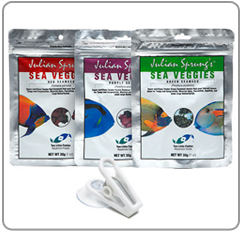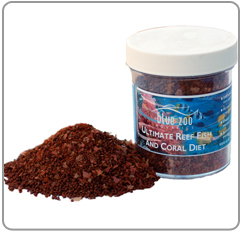|
Guest Julian Sprung on Feeding Herbivores
Mark Martin is Director of Marine Ornamental Research at Blue Zoo Given our focus on herbivorous fishes in this issue of Blue Zoo News, I want to think a little bit about feeding those herbivores as my “Ask Mark” tip of the week. Since we had the opportunity recently to interview Julian Sprung (be sure to read the whole interview), creator of the very popular Sea Veggies herbivorous fish foods, I've decided to invite Julian to provide my tip of the week regarding what to feed your herbivorous fishes. So, Julian, what should our readers feed their herbivorous fishes?

“Thanks for the opportunity, Mark. In my opinion, flake foods are a good staple for herbivores. This is particularly true of the Spirulina enhanced varieties, but even the high fish protein flakes are suitable for herbivores, though it is best if some seaweed is also offered to them each week. It's really important to understand that flake foods can leach much of their nutritional content within a short while after they hit the water, so make sure to not put too much flake food in the water at once. If you feed just what the fishes will eat within a few seconds, and then offer more, you have the ideal situation.
“Three other too often overlooked tips regarding flake foods--first, they should be fed into a feeding point (floating ring). Otherwise the flakes may be drawn into overflow drain. Second, flake foods should be stored in the refrigerator after opening—not in the aquarium stand or hood where the humidity and heat rapidly destroy their nutritional value. Third, and finally, you should buy what will be used in a few months. Flake food in a can that has been open for a year and left at room temperature should be discarded."
One other question, if I may, Julian. What is the a nutritional difference between Porphyra umbilicalis, Porphyra yezoensis and Palmaria palmata, and how does knowing this help the marine aquarist?

“The algae you mention are the purple, green and red varieties of Two Little Fishies' SeaVeggies. They have different contents of protein, fiber and fat, but this is not of much consequence to the marine aquarist. Some fishes prefer one variety over another while others eat all of them. There are significant differences in the texture and taste that affect the preferences of different fishes. It is not possible to predict which variety a particular type of fish will prefer. However, it is predictable that if a fish prefers one variety, switching to another variety is often difficult. Fish develop habitual preferences, unlike dogs, which prefer anything new.”

Thank, Julian! All good advice for sure. Speaking of Spirulina enhanced foods, I would like to add that, in addition to Sea Veggies, Blue Zoo Mix is a great food for herbivores. Our own formula is a dry food that contains a special recipe pellet food from New Life Spectrum as well as fresh Spiralina flake. The real winner in the food is the high concentration of both Cyclopeeze and Golden Pearls making our food a complete diet for both fish and coral.
Published 3 June 2008. © Blue Zoo Aquatics
|